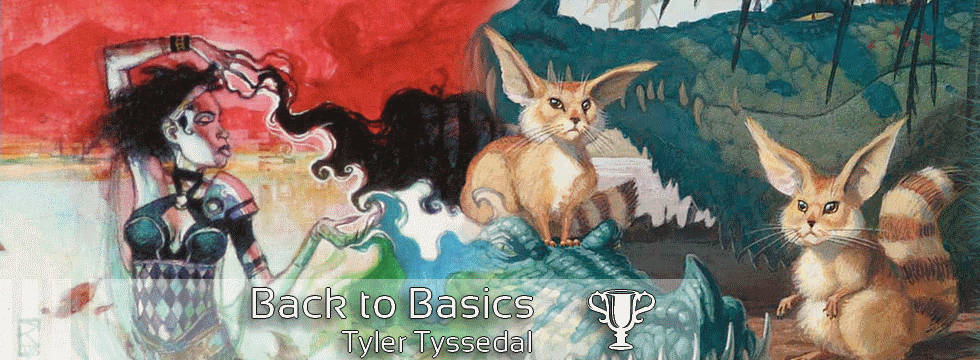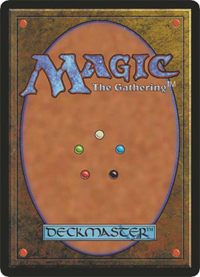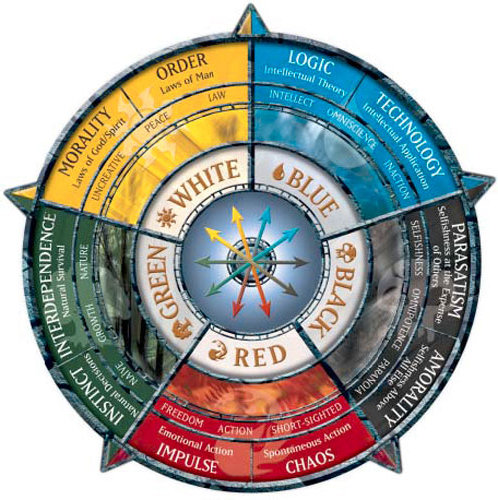Are you a Quiet Speculation member?
If not, now is a perfect time to join up! Our powerful tools, breaking-news analysis, and exclusive Discord channel will make sure you stay up to date and ahead of the curve.
Today we’ll begin a thorough dissection of Magic’s five colors, perfect for newcomers and a refreshing review for veterans. After exploring the Color Wheel, we’ll move onto the series’ first installment. You’ll find all the Green cards you can expect to see in Legacy alongside decklists galore.
SERIES INDEX
- The Color Wheel and Legacy: Intro
- The Color Wheel and Legacy: Green
- The Color Wheel and Legacy: White
INTRODUCTION
Legacy’s a rich format.
What does that mean? Let’s take a quick step back. If you have a full understanding of what Legacy is, you may go right ahead and skip the next little section.
If you would also prefer to skip past the Color Wheel primer, scroll down or click here.
What is Legacy?
Legacy is one of the two Eternal Constructed formats, the other being Vintage. We’re not going to get into Vintage right now.
To put it simply, what separates Legacy from Standard is the fact that Legacy’s card pool never rotates. If you play Standard, you know that blocks get dropped after they’ve been in the format for a while. Standard limits the card pool in a revolving door sort of way.
Legacy never drops a block.
Sure, there is a list of banned cards that gets updated in order to keep the format balanced, but you won’t find whole sets of cards being eliminated. The banned list gets tweaked in minor ways. Sometimes nothing happens, sometimes Vengevine gets printed and makes Survival of the Fittest absurd. And sometimes [card Time Spiral]cards are unbanned[/card].
With over 11,000 cards to play with, the innovation and exploration continues with each new set.
If the existing card pool were a familiar cave full of stalactites, the new interactions and combos that come from new cards would be the sudden stalagmites that appear from nowhere on the ground. Sure, the stalactites were always there, but we had no way of knowing they would one day produce something worthwhile.
This keeps the format fresh.
The Color Wheel: A Primer
The consistency of beauty and balance of Magic as an ever-expanding game can be attributed to the Color Wheel.
If you’ve ever looked on the back of a Magic card, you’ll be familiar with this:
You may also have a very strong understanding of what the colors in the middle of this card represent, how they interact with one another, and which you prefer to wield. You can find a very thorough wiki article over at MTG Salvation. Since I’m not one to make a new wheel just to call it mine, and since I appreciate all of the hard work that has gone into constructing such a great resource, I will be using their wiki as a source.
The "Color Pie" (a.k.a. "Color Wheel") is a representation of Magic colors and their mechanics, and how Wizards categorizes mechanics in the game of Magic: The Gathering. It is also how one differentiates the philosophies behind the colors. The Color Pie is a simple tool for players less familiar with each color's workings to become acquainted with the surface of their philosophies, their strengths, and their weaknesses.
-MTG Salvation Wiki
© Wizards of the Coast
I would also highly recommend reading Mark Rosewater’s article from 2003 over at Wizards.com.
Following the circle of gems on the back of every Magic card we find that the colors rotate in a clockwise fashion from White to Blue to Black to Red to Green, and then back White.
The adjacent colors are commonly known as allied colors. Allied colors interact most naturally with other allies, while the remaining colors are considered enemy colors. For example, White’s allies are Blue and Green and its enemies are Black and Red. The reasoning behind this begins to make more sense when we consider each color’s trait, as classified on the wiki:
- White: Organization
- Blue: Intelligence
- Black: Self Concern
- Red: Emotion
- Green: Instinct
We see this alignment in Onslaught’s printing of allied fetch lands. Notice how the colors blend together?:
And Zendikar’s enemy fetches, following the same order or rotation around the wheel:
An awareness of how the colors interact and complement one another can be helpful when understanding how to play—or play against—a deck of more than one color. Color combinations, however, are by no means prescriptively restrictive, as two Blue/White decks may play completely differently depending upon the cards used.
While the flavor of Magic lore can be fascinating and of interest, the main focus of this article is how the Color Wheel relates to Legacy as a format. If you would like to learn more, there’s quite a bit of information out there. The MTG Salvation wiki has coalesced it quite conveniently.
THE COLOR WHEEL AND LEGACY: GREEN
Green is the color most in tune with nature. Whereas the other colors seek to modify the world around them, green believes that the best course of action is to simply allow nature to take its course. Thus, green is often seen as the least confrontational of the colors: it does not seek to impose its values on others; it just wants to coexist as peacefully as possible. This does not mean that green will not defend itself when it feels threatened, but it generally will not seek to impose its opinion on others.
Green’s Role in Legacy
Although not as intimidating as it once was, there’s something about Craw Wurm that just makes you want to cast it. The problem, of course, has always been that it costs 6 mana. It’s a big creature that needs big mana. That is what Green is most well known for.
As creatures have been creeping up on power, with an [card Tarmogoyf]often 5/6[/card] for 2 and [card Wild Nacatl]3/3[/card] for 1, Craw Wurm has become outclassed.
Still, Green’s primary purpose in Legacy is to provide its caster with a big body. Although the color provides other services, such as the acceleration of a Birds of Paradise or Noble Hierarch, you will mostly find that Green is splashed to support Tarmogoyf and sideboarded [card Krosan Grip]Krosan Grips[/card].
If another color is already present, it’s not hard to work in a few Knight of the Reliquary or Maelstrom Pulse.
The only mono-Green deck that is currently viable is Elves. There are a few routes and directions one can go with the archetype, but we’ll get to that later.
Green Cards You’ll See
In the meantime, I’ve compiled a list of the most common green cards you may run across in any particular meta. Keep in mind that there are always players digging up uncommonly played cards, so this list is by no means absolute.
Creatures
Non-creature Spells
Multicolored
Notable, However Uncommon
Green Decks
You will (likely) find Green cards in three types of decks:
- Elves
Elves is, without a doubt, the Greenest, most traditionally flavorful Magic archetype around. There is, however, no single list adopted as the best list, so there’s a lot of room available for tweaking.Of the builds, the three most abundant fall into one of three categories, each also capable of delivering a beatdown with access to [card Elvish Archdruid]lords[/card] and [card Ezuri, Renegade Leader]overrun on a stick[/card]: Hardcasting [card Emrakul, the Aeons Torn]Emrakul[/card], sometimes supported by Food Chain or Glimpse of Nature; [card Natural Order]Ordering[/card] Progenitus; and a nifty trick of [card Buried Alive]burying[/card] or [card Intuition]Intuitioning[/card] Vengevine, although it requires a little splash.
In many ways it’s right to consider Elves a combo deck. It’s also susceptible to hate, having a fair amount of trouble working around a resolved Engineered Plague, Perish, or Engineered Explosives at 1.
Elves is packed full of Green creatures that don’t see play in many other decks. It is one of the three competitive tribal strategies, the other two being Goblins and Merfolk. It is also one of the few Green creature decks with no Tarmogoyf.
- "Combo"
You’ll find Xantid Swarm in the sideboard of most combo decks—such as TES and Belcher—as counter protection. [card Goblin Charbelcher]Belcher[/card] also relies on Elvish Spirit Guide, Tinder Wall, and Manamorphose, and some of Dredge's most efficient cards are green. Enchantress takes advantage the color’s enchantments, and Lands, although not really a combo deck, plays quite a few land advantage cards like Exploration and Life from the Loam. Eldrazi Post, another faux-combo deck, takes advantage of the land opportunities green presents.It's true that not all of the decks I'm classifying as "combo" decks are actually combo decks, and a few of the true combo decks don't deserved to be mocked as "combo" in quotations. I suppose this title doesn't really fit anywhere, does it? But we'll keep it for now anyway. If you have a better lumpy-group name, please let me know.
- Tarmogoyf
If a deck is running both Green and creatures, it’s rare that Tarmogoyf isn’t somewhere in the 75. The [card Tarmogoyf]Goyf[/card] opens the door to other cards being invited, whether he’s the lone creature or not. Still, even though I am classifying this section as [card Tarmogoyf]Goyf[/card]'s doing, there are some decks out there that do without the two drop, but Green is still primarily splashed for its creatures.Of the decks that splash green for [card Tarmogoyf]Goyf[/card] and friends are: Zoo, Eva Green, The Rock, Junk, G/W Aggro, Canadian Thresh, Team America, BUG Disruption, New Horizons, Bant Aggro, NO Bant, NO RUG, Stiflenought, Countertop, and Green & Taxes.
Only three creatures routinely seeing play that get bigger than Tarmogoyf are Knight of the Reliquary, Terravore, and Tombstalker. For a colorless and a Green, you can’t find anything more efficient than Tarmogoyf in terms of vanilla power. Decks splash Green solely for him, but he does lack evasion and anything "interesting".
Note: I will be using Star City Games’ results and deck lists because they host the largest scale Legacy tournaments on a relatively consistent basis. While there is no way to “check the temperature“ of every meta, SCG’s events are worth paying attention to.
Collapse All Decklists
Elves
Elves by David Vo
4th at a StarCityGames.com Legacy Open tournament
Atlanta, Georgia, United States on 2011-04-03
[expand title="Click to Show Decklist"]
Untitled Deck
[/expand]
Elves by Matt Sperling
13th at a StarCityGames.com Legacy Open tournament
Los Angeles, California, United States on 2011-03-27
[expand title="Click to Show Decklist"]
Untitled Deck
[/expand]
Elves by Wil Strickland
6th at a StarCityGames.com Legacy Open tournament
Los Angeles, California, United States on 2011-03-27
[expand title="Click to Show Decklist"]
Untitled Deck
[/expand]
Elves by Nicholas Malatesta
3rd at a StarCityGames.com Legacy Open tournament
Boston, Massachusetts, United States on 2011-04-24
[expand title="Click to Show Decklist"]
Untitled Deck
[/expand]
"Combo"
TES by Liam Kane
3rd at a StarCityGames.com Legacy Open tournament
Los Angeles, California, United States on 2011-03-27
[expand title="Click to Show Decklist"]
Untitled Deck
[/expand]
Belcher by Christian Valenti
4th at a StarCityGames.com Legacy Open tournament
Atlanta, Georgia, United States on 2010-05-02
[expand title="Click to Show Decklist"]
Untitled Deck
[/expand]
Dredge by Frankie Mach
4th at a StarCityGames.com Legacy Open tournament
Los Angeles, California, United States on 2011-03-27
[expand title="Click to Show Decklist"]
Untitled Deck
[/expand]
Enchantress by Kevin Stratton
11th at a StarCityGames.com Legacy Open tournament
Charlotte, North Carolina, United States on 2011-05-01
[expand title="Click to Show Decklist"]
Untitled Deck
[/expand]
Lands by Adam Cai
8th at a StarCityGames.com Legacy Open tournament
Fort Worth, Texas, United States on 2011-03-20
[expand title="Click to Show Decklist"]
Untitled Deck
[/expand]
Eldrazi Post by Andrew Stekley
13th at a StarCityGames.com Legacy Open tournament
Memphis, Tennessee, United States on 2011-03-13
[expand title="Click to Show Decklist"]
Untitled Deck
[/expand]
Tarmogoyf
Zoo by John DeAngelos
16th at a StarCityGames.com Legacy Open tournament
Atlanta, Georgia, United States on 2011-04-03
[expand title="Click to Show Decklist"]
Untitled Deck
[/expand]
Eva Green by Andy Ellis
14th at a StarCityGames.com Legacy Open tournament
Kansas City on 2011-01-09
[expand title="Click to Show Decklist"]
Untitled Deck
[/expand]
The Rock by Alex Hon
12th at a StarCityGames.com Legacy Open tournament
Fort Worth, Texas, United States on 2011-03-20
[expand title="Click to Show Decklist"]
Untitled Deck
[/expand]
Team America by Edgar Flores
7th at a StarCityGames.com Legacy Open tournament
Orlando, Florida, United States on 2011-05-15
[expand title="Click to Show Decklist"]
Untitled Deck
[/expand]
Team America (BUG Disruption) by Josh Jacobson
5th at a StarCityGames.com Legacy Open tournament
Orlando, Florida, United States on 2011-05-15
[expand title="Click to Show Decklist"]
Untitled Deck
[/expand]
G/W Aggro by Marsh Usary
9th at a StarCityGames.com Legacy Open tournament
Atlanta, Georgia, United States on 2011-04-03
[expand title="Click to Show Decklist"]
Untitled Deck
[/expand]
G/W Aggro (Green & Taxes ) by Shawn French
12th at a StarCityGames.com Legacy Open tournament
Atlanta, Georgia, United States on 2011-04-03
[expand title="Click to Show Decklist"]
Untitled Deck
[/expand]
Canadian Threshold by Josh Cico
1st at a StarCityGames.com Invitational Qualifier tournament
Vestal, New York, United States on 2011-03-20
[expand title="Click to Show Decklist"]
Untitled Deck
[/expand]
New Horizons by Shane Remelt
16th at a StarCityGames.com Legacy Open tournament
Fort Worth, Texas, United States on 2011-03-20
[expand title="Click to Show Decklist"]
Untitled Deck
[/expand]
Bant Aggro by Caleb Durward
5th at a StarCityGames.com Legacy Open tournament
Atlanta, Georgia, United States on 2011-04-03
[expand title="Click to Show Decklist"]
Untitled Deck
[/expand]
NO Bant by Todd Anderson
8th at a StarCityGames.com Legacy Open tournament
Atlanta, Georgia, United States on 2011-04-03
[expand title="Click to Show Decklist"]
Untitled Deck
[/expand]
NO RUG by David Nolan
4th at a StarCityGames.com Legacy Open tournament
Charlotte, North Carolina, United States on 2011-05-01
[expand title="Click to Show Decklist"]
Untitled Deck
[/expand]
Stiflenought by Andrew Cavenaugh
14th at a StarCityGames.com Legacy Open tournament
Charlotte, North Carolina, United States on 2011-05-01
[expand title="Click to Show Decklist"]
Untitled Deck
[/expand]
Counter-Top by Gerry Thompson
2nd at a StarCityGames.com Legacy Open tournament
San Jose, California, United States on 2011-01-16
[expand title="Click to Show Decklist"]
Untitled Deck
[/expand]
Collapse All Decklists
Until Next Time…
I will be at Grand Prix Providence this upcoming weekend (May 28th-29th). If you're there, be sure to track me down and say hey.
Given that, the next installment of this series may or not be ready by next week.
It is my hope that this and the following installations of The Color Wheel and Legacy will be a great starting point for those who are wishing to migrate into Legacy but a little apprehensive due to the sheer variety and unfamiliar meta.
If there is anything else you'd like to see in this and the following articles, please leave some feedback.
It's also worth noting that some Legacy players have an intimidating demeanor when it comes to welcoming a new player to the format. Sadly, for some, this observation may then be inaccurately projected onto the Legacy community as a whole.
It takes a little effort to overturn this assumption, but I encourage you that it would be worth working toward. A thriving local scene only makes the game (and trades!) better. Lots of people play Magic for the social aspect, so it's important to not forget that.
Please be good to each other and remember that you can catch more flies with honey than vinegar.
Because no one likes a vinegary Magic player.
Until next time,
Tyler Tyssedal








I like the series already, and this is a really complete article. Keep up the good work!
Thanks Corbin! It's been a fun series to research and write, too.
Finally got around to reading this. Really informative. It's actually getting me interested in playing Legacy. Only thing holding me back is dropping the coin on those darned dual-lands.
Glad to hear it!
Duals are definitely the main investment when getting into Legacy, the other being your (Blue-willing) set of Force of Wills. Goyfs have even gone down a bit in price, landing at a reasonable $50 or so right now. Bob is another card that is good to have… plus, Wasteland. A set of those is worth tracking down over time, as are older fetchlands (as well as the new ones!).
In the meantime, as you build your Legacy collection, there are a few non-dual options out there when looking to first get into Legacy, if you're considering not running your favorite deck off the bat. I would work toward getting sets of duals as it opens you up to being able to play nearly everything, but start with the deck you want to play most.
For "budget" Legacy decks, Burn is actually fairly competitive right now, although I wouldn't want to pilot it for too terribly long. You can get most of the cards foiled from the Fire and Lightning set, which you can sometimes find at Target for $17. Two of those sets push you on your way to crushing illprepared players. No one ever expects a runner runner runner of Fireblasts.
Although Moat is absurdly pricey, Enchantress may be worth considering as there are only a few expensive cards. It's also crazy fun (and complicated) to pilot.
Merfolk, too, is fairly affordable. Wastelands and Forces are your main culprits when skirting around cost. Then there's Dredge, which is likely the cheapest deck around and usually takes game 1.
Hope this helps and encourages a bit! Look for the next installment of Red if you're interested in Burn as an opening. Once you get a deck you can often find big tournaments that have duals and forces as prizes, which is the classic way of working your way up.